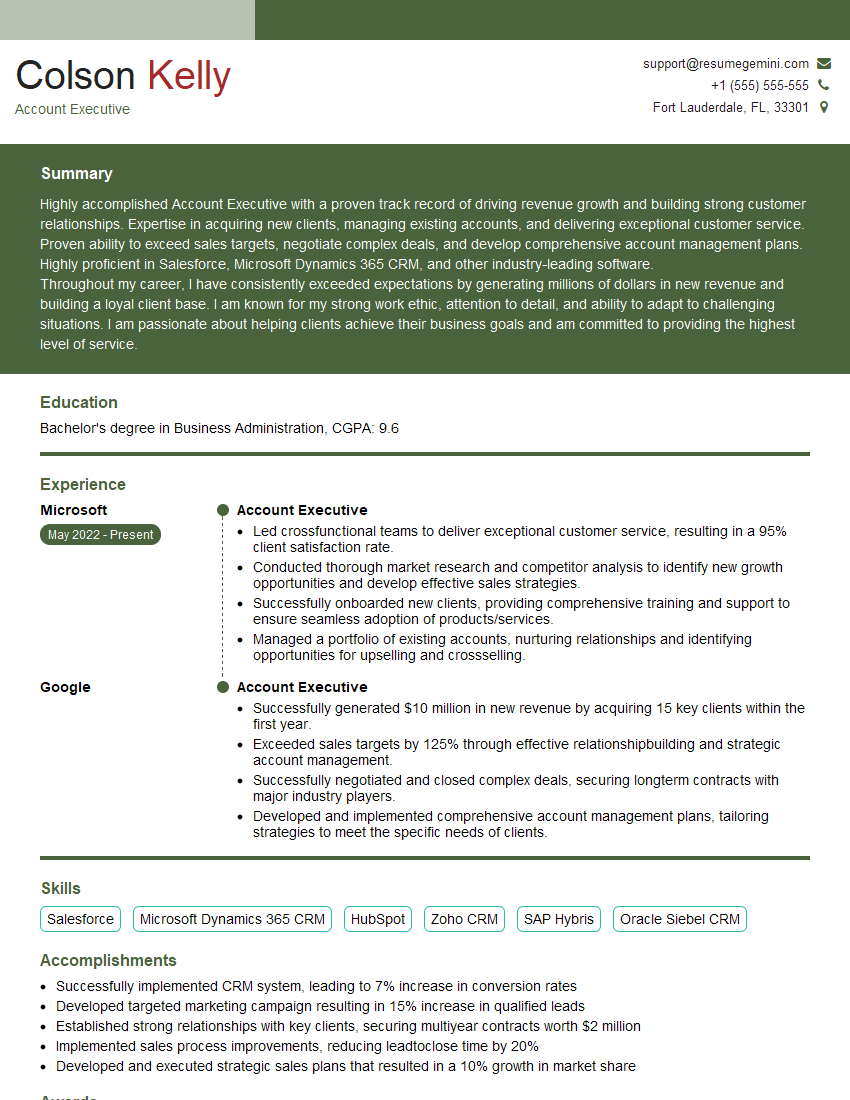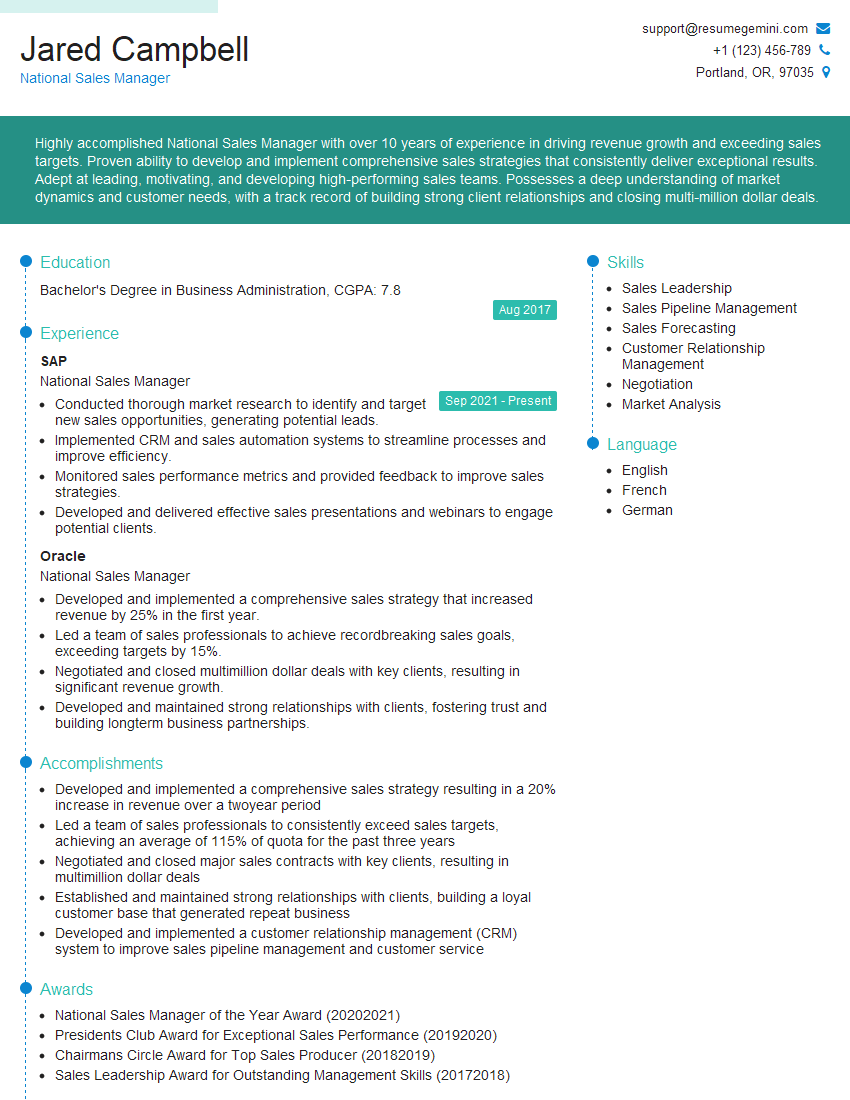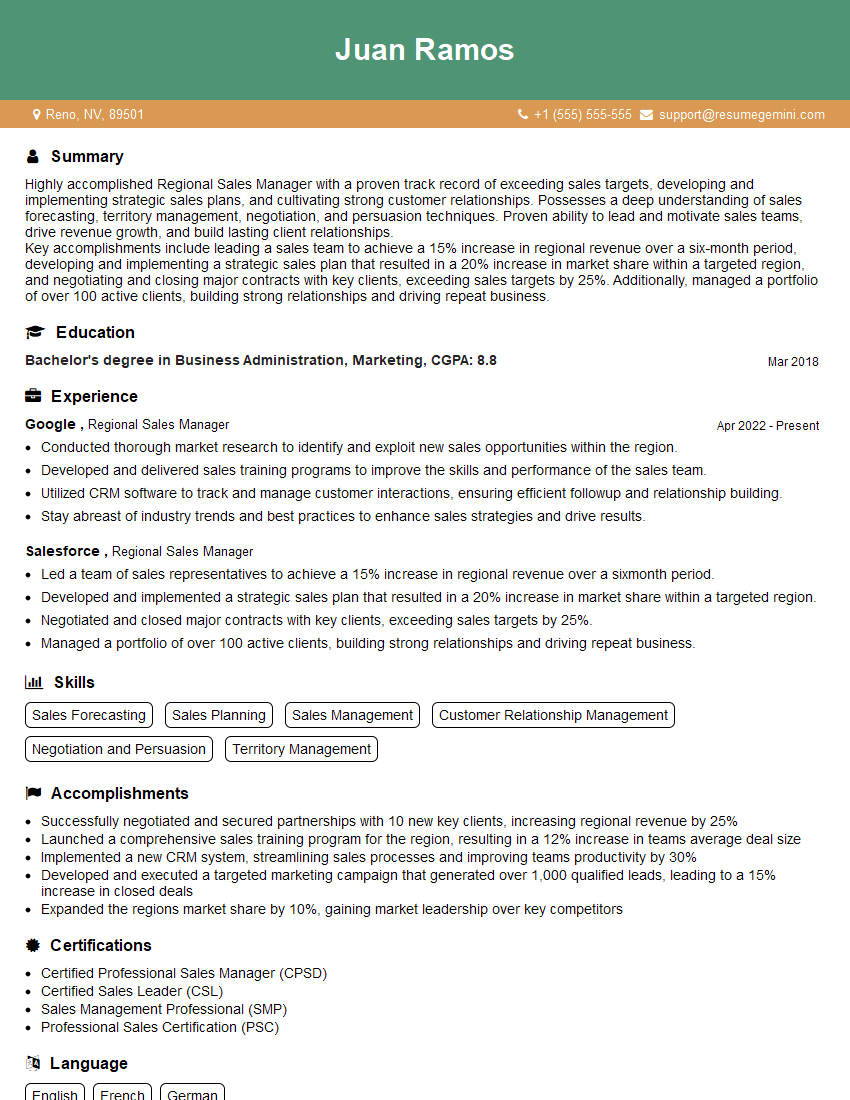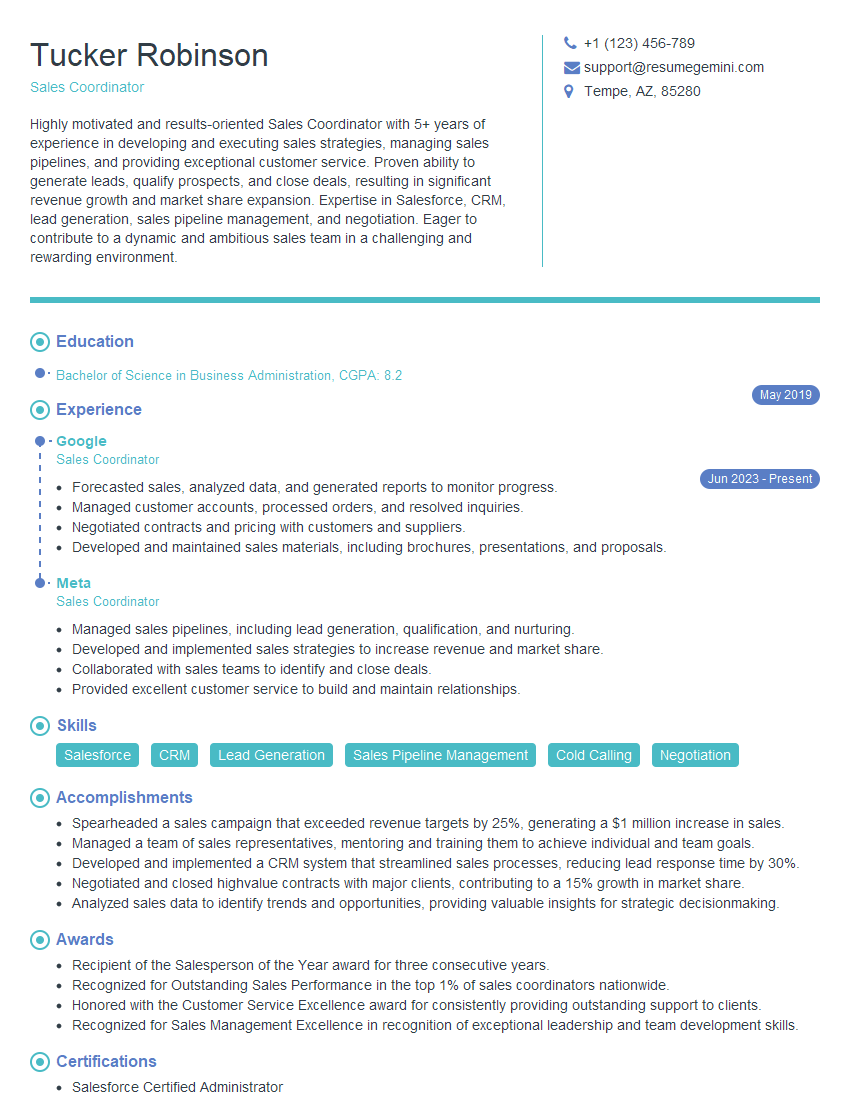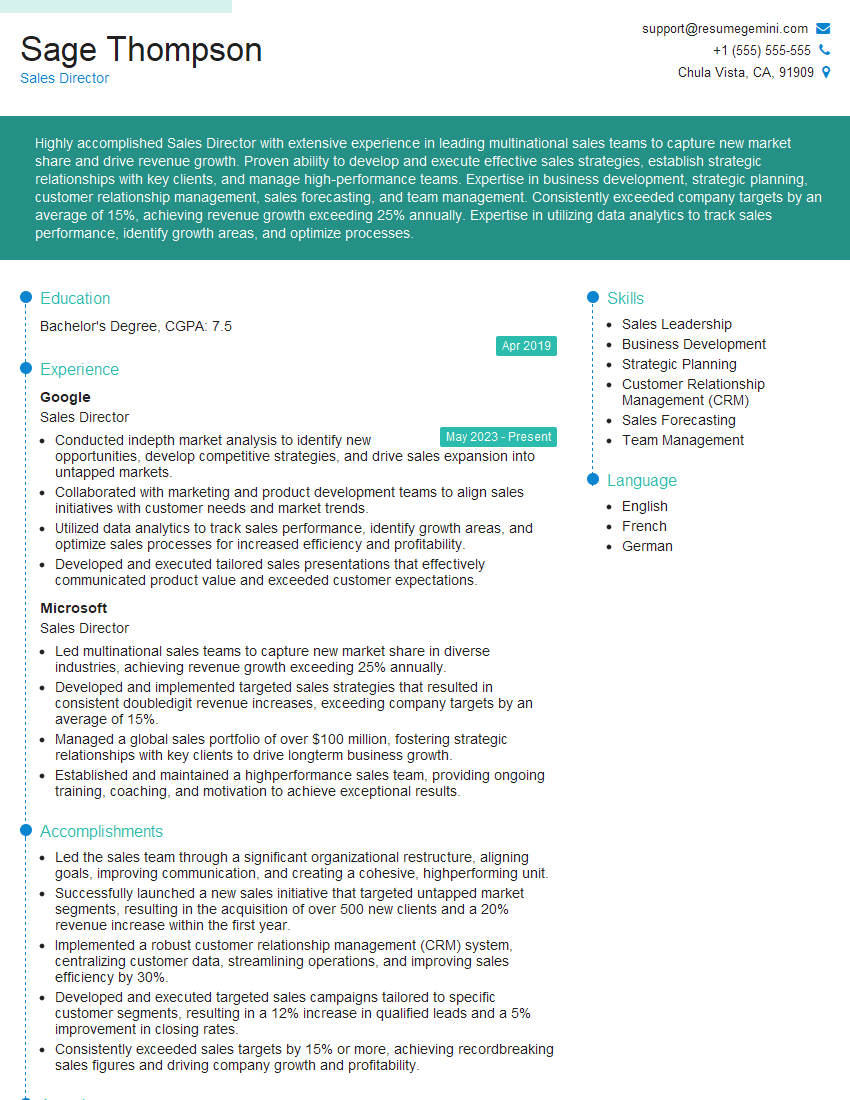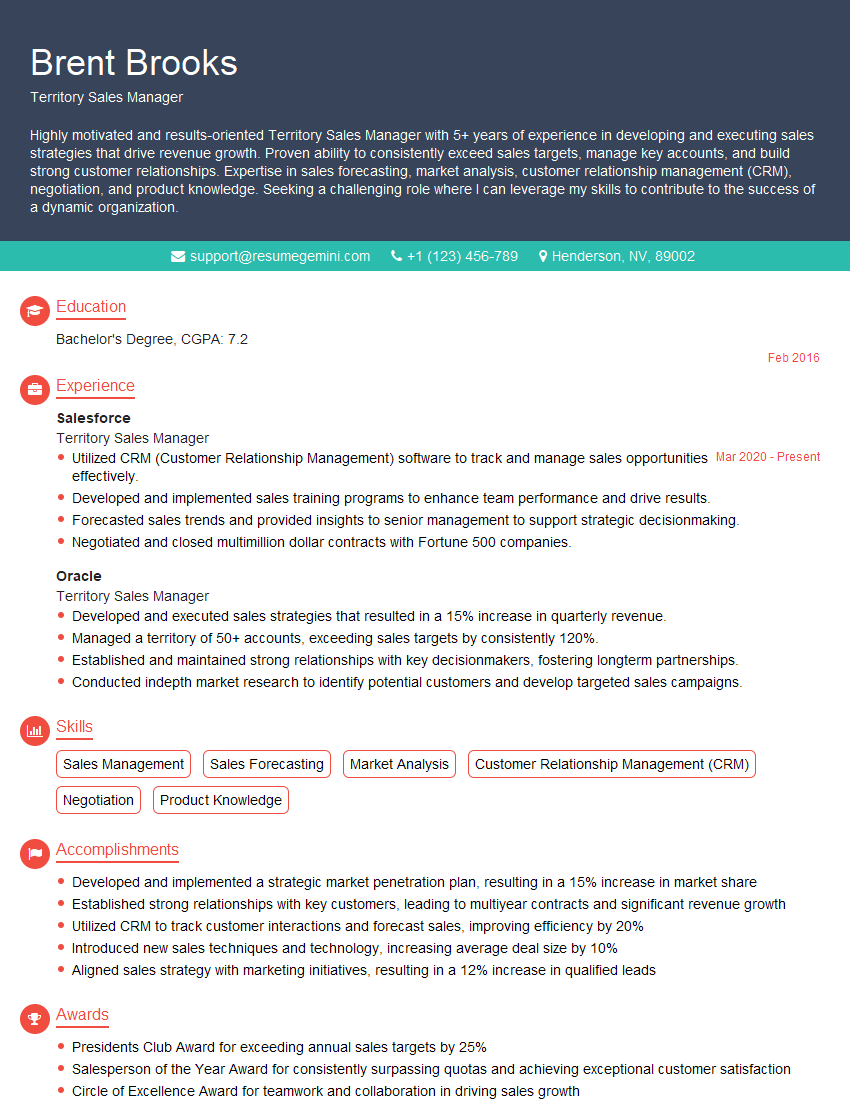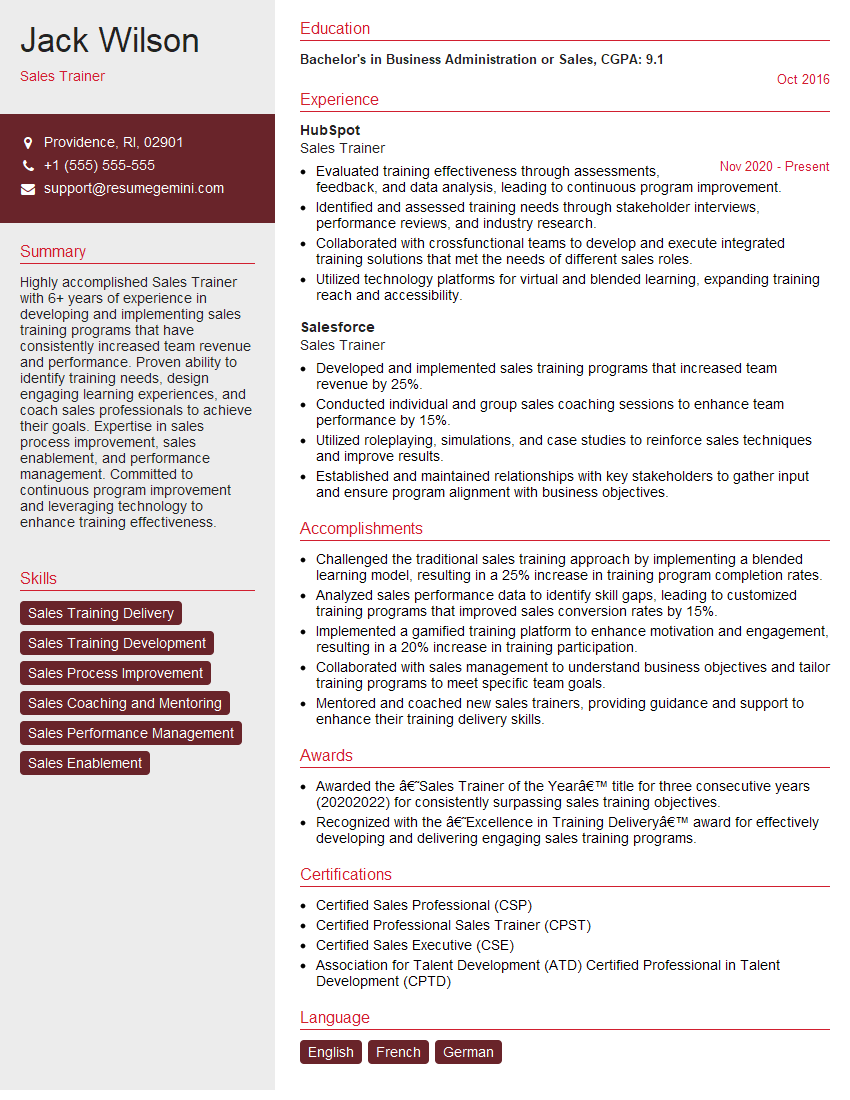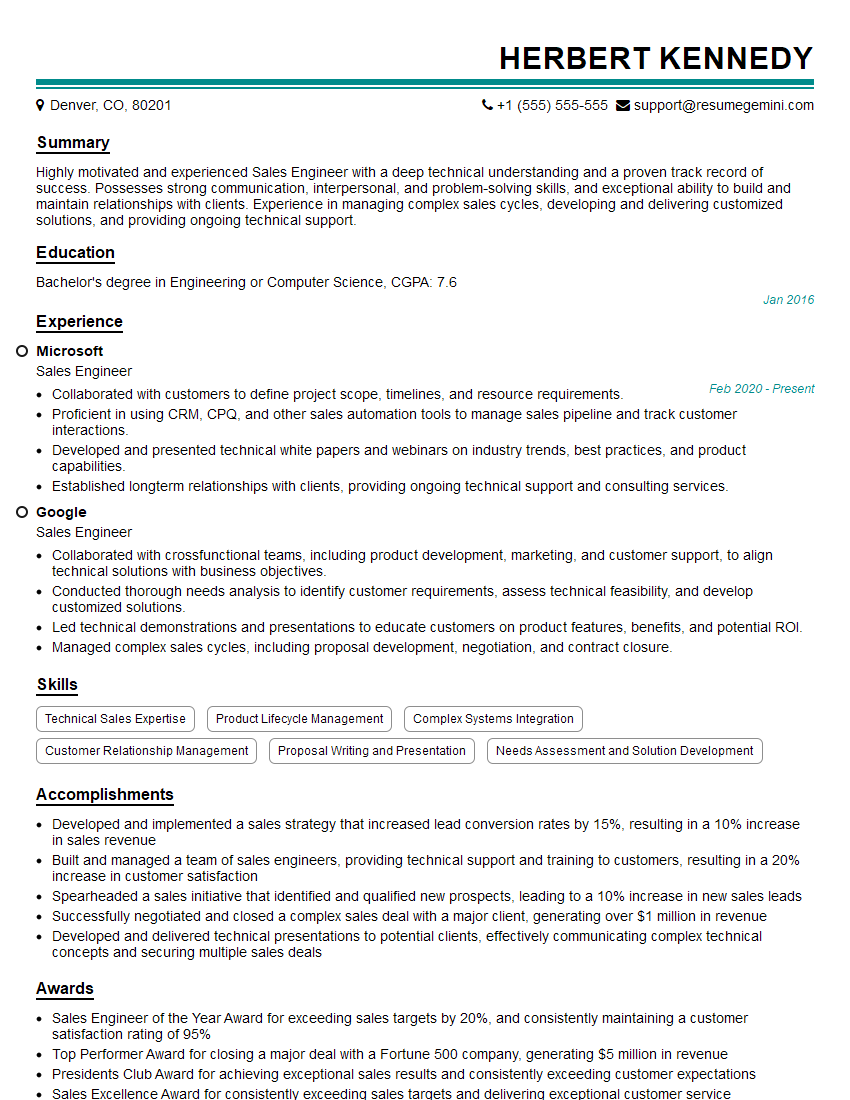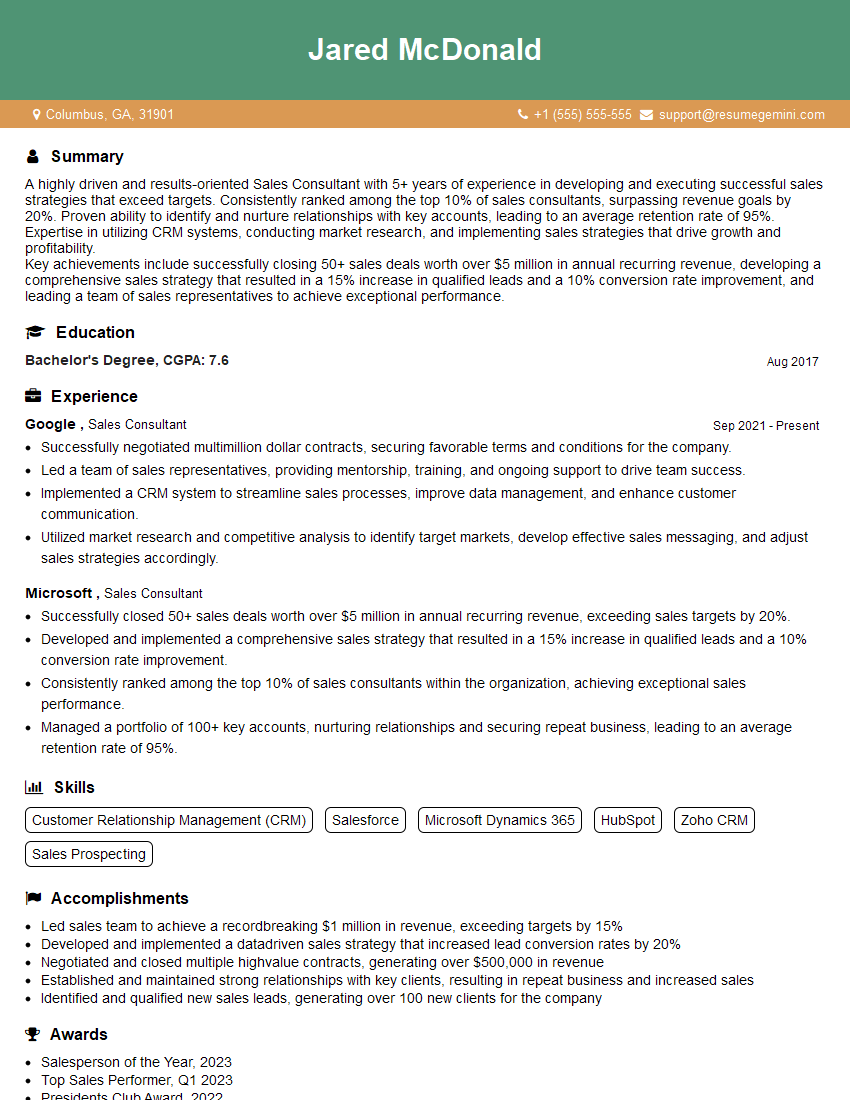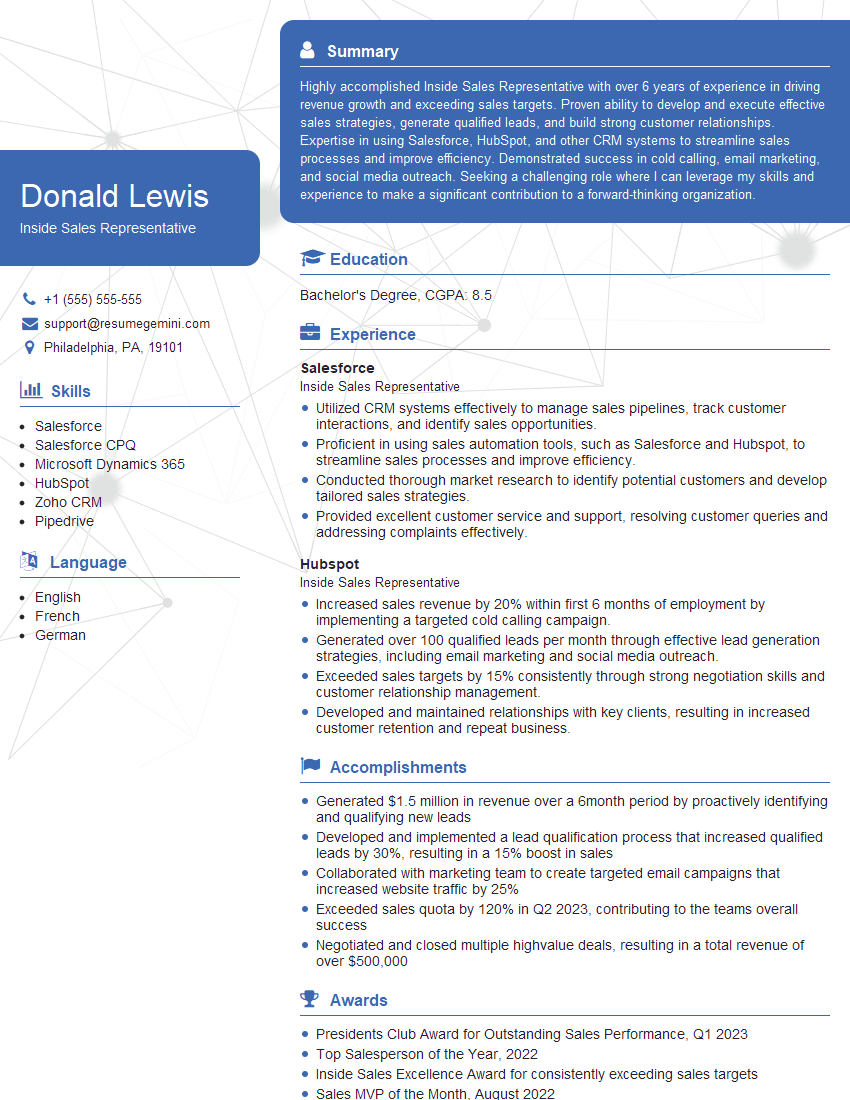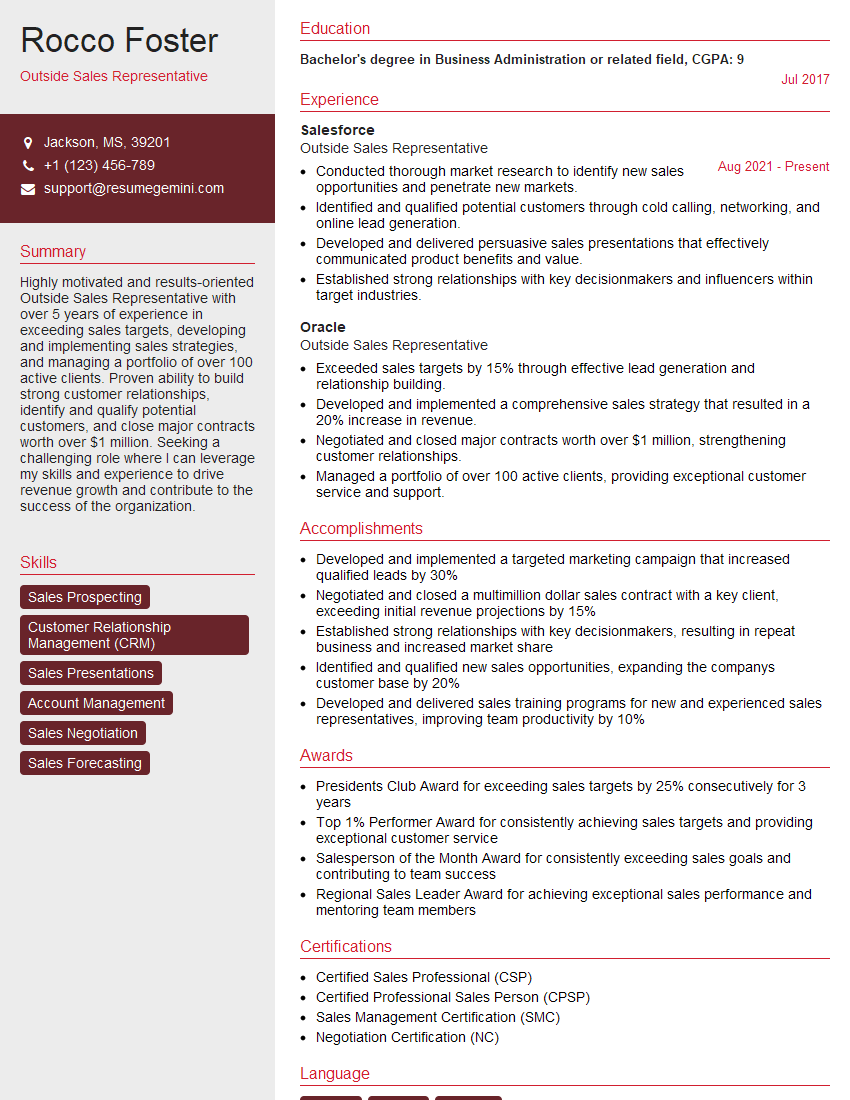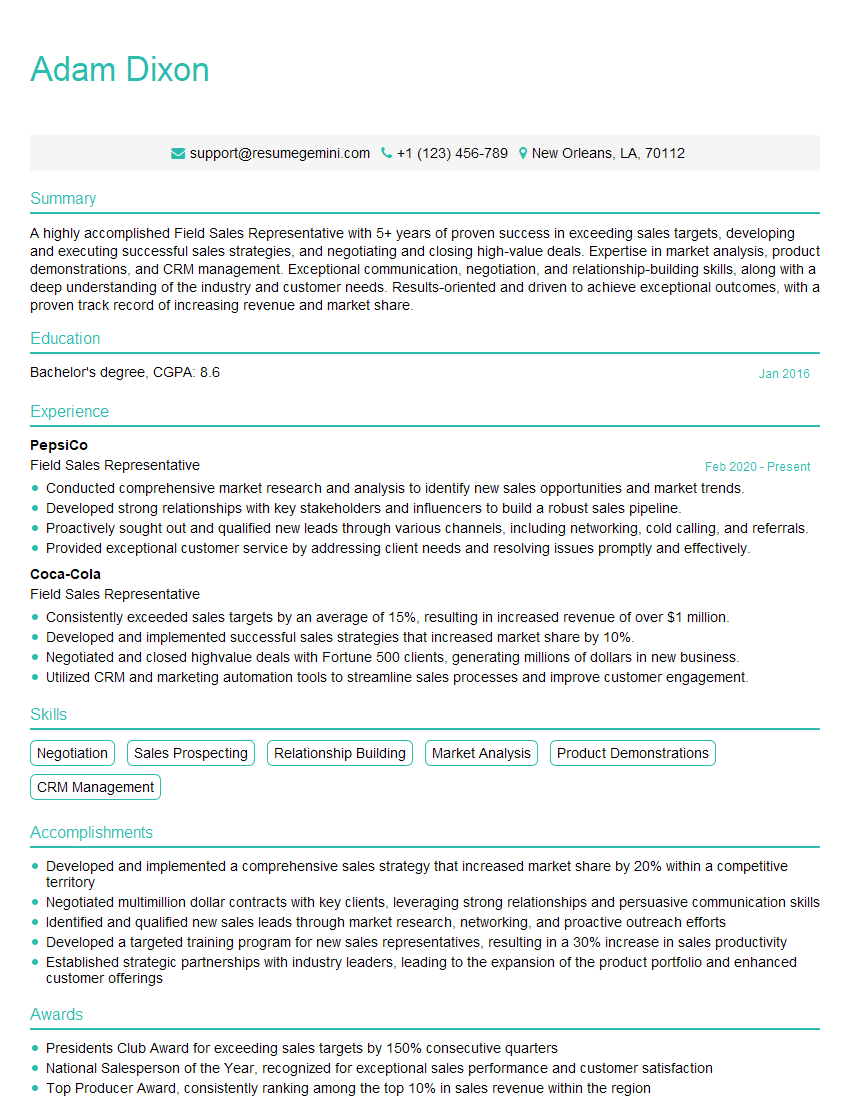The right preparation can turn an interview into an opportunity to showcase your expertise. This guide to Knowledge of Sales interview questions is your ultimate resource, providing key insights and tips to help you ace your responses and stand out as a top candidate.
Questions Asked in Knowledge of Sales Interview
Q 1. Explain your understanding of the sales cycle.
The sales cycle is the series of steps a salesperson takes to convert a prospect into a paying customer. It’s a journey, not a sprint, and understanding its stages is crucial for effective sales. Think of it like a funnel, with a wide top representing many potential leads, narrowing down to a smaller number of closed deals at the bottom.
- Prospecting: Identifying and researching potential clients who fit your ideal customer profile (ICP).
- Qualifying: Determining if a prospect has the need, budget, and authority to make a purchase.
- Needs Analysis: Understanding the prospect’s specific pain points and how your product or service can address them. This involves active listening and asking insightful questions.
- Presentation/Proposal: Demonstrating the value proposition of your offering and tailoring it to the prospect’s needs. This might involve a formal presentation, a product demo, or a proposal outlining the solution.
- Handling Objections: Addressing any concerns or doubts the prospect might have. This requires empathy, strong communication skills, and a solutions-oriented approach.
- Closing: Securing the sale by asking for the commitment. This often involves negotiating terms and finalizing the agreement.
- Follow-up/Retention: Ensuring customer satisfaction after the sale to foster loyalty and encourage repeat business.
For example, in my previous role selling SaaS software, we meticulously followed a sales cycle that emphasized needs analysis and demonstrating ROI. We used case studies and customer testimonials to build trust and overcome objections during the presentation phase.
Q 2. Describe your experience with different sales methodologies (e.g., SPIN selling, MEDDIC).
I’ve had extensive experience with several sales methodologies, tailoring my approach to the specific product, customer, and sales environment.
- SPIN Selling: This methodology focuses on asking strategic questions to uncover the prospect’s needs and challenges. I’ve successfully used SPIN selling in B2B sales environments by employing Situation, Problem, Implication, and Need-Payoff questions to guide the conversation and highlight the value of our solution. For instance, I would start by asking about their current workflow (‘Situation’), then probe into pain points related to that workflow (‘Problem’), exploring the implications of those pain points on their business (‘Implication’), before finally showcasing how our product resolves these issues (‘Need-Payoff’).
- MEDDIC: This framework is ideal for complex sales cycles involving multiple stakeholders. I’ve used MEDDIC (Metrics, Economic Buyer, Decision Criteria, Decision Process, Paper Process, Champion) to qualify leads and manage the sales process in enterprise sales. By carefully identifying the economic buyer, decision criteria, and the overall decision process, I ensured a smoother and more efficient sales cycle, leading to higher conversion rates. For example, I carefully mapped out each stakeholder’s role and influence to ensure clear communication and alignment throughout the process.
I believe in adapting my approach based on the specific situation. A simple sales cycle might only require a basic needs analysis, while a complex enterprise sale necessitates a robust methodology like MEDDIC.
Q 3. How do you qualify leads and prioritize your sales efforts?
Lead qualification is critical to maximizing sales efficiency. I use a combination of methods to qualify leads and prioritize my efforts:
- BANT: Budget, Authority, Need, Timeline – This classic framework helps determine if a prospect has the financial resources, decision-making power, genuine need for your product, and a realistic timeline for purchase.
- Ideal Customer Profile (ICP): I define a clear ICP based on demographics, firmographics, and behavioral characteristics. This helps me focus on the most promising leads and prioritize my time. I only pursue leads that closely align with this profile.
- Lead Scoring: I utilize lead scoring systems (either manual or automated) that assign points based on various factors like engagement level, website activity, and demographic information. Higher-scoring leads receive immediate attention.
For instance, if a lead shows high website engagement but lacks a defined budget, I might prioritize further qualification through targeted outreach and discovery calls before investing significant time. My goal is to focus on leads with a high probability of conversion, maximizing ROI on my efforts.
Q 4. What CRM systems are you familiar with, and how have you used them?
I’m proficient with several CRM systems, including Salesforce, HubSpot, and Zoho CRM. My experience spans both using them for individual sales management and configuring them for team-wide utilization.
- Salesforce: I’ve used Salesforce to manage leads, track opportunities, forecast sales, and analyze sales performance. I’m familiar with its reporting and analytics capabilities, allowing me to identify trends and areas for improvement.
- HubSpot: I’ve leveraged HubSpot for its integrated marketing and sales functionalities, utilizing its features for lead nurturing, email marketing automation, and sales pipeline management.
- Zoho CRM: My experience with Zoho includes managing contacts, tracking interactions, and generating reports. Its cost-effectiveness and ease of use make it suitable for smaller businesses.
In each case, I leverage the CRM to streamline my workflow, enhance collaboration, and gain valuable insights into sales performance. I ensure data accuracy and regularly update the system to maintain a real-time view of my pipeline and overall progress.
Q 5. Describe your approach to handling objections from potential clients.
Handling objections is a critical skill for successful sales. My approach is based on active listening, understanding the underlying concern, and providing a tailored solution.
- Listen Carefully: I start by letting the prospect fully express their objection without interruption. This shows respect and allows me to understand their perspective.
- Empathize and Acknowledge: I acknowledge their concerns and demonstrate empathy. For instance, saying, ‘I understand your hesitation; many clients initially feel the same way’ can create a connection.
- Address the Objection Directly: I directly address the objection using evidence, testimonials, or case studies to support my claims.
- Reframe the Objection: Sometimes, an objection is based on a misunderstanding. I reframe it to clarify the value proposition and address the underlying concern.
- Offer Solutions: I proactively provide solutions to overcome the objection. This could involve adjusting the pricing, offering a trial period, or clarifying the terms and conditions.
For instance, if a prospect raises concerns about the price, I would first understand their budget constraints and then discuss the ROI they can expect from the product. I might also highlight the long-term cost savings or offer different pricing packages to meet their needs.
Q 6. How do you build rapport with clients and maintain long-term relationships?
Building strong client relationships is fundamental to long-term success. It’s about fostering trust and mutual respect. My approach involves:
- Active Listening: Paying close attention to what the client says, both verbally and nonverbally, to understand their needs and concerns.
- Personalized Communication: Tailoring my communication style to match the client’s preferences, demonstrating genuine interest in their business and challenges.
- Value-Added Service: Going above and beyond to provide exceptional service, even after the sale, by offering additional support, resources, or information.
- Regular Follow-up: Maintaining contact through regular check-ins, newsletters, or other forms of communication to stay top-of-mind and build rapport.
- Proactive Problem Solving: Anticipating potential issues and proactively addressing them before they escalate, demonstrating commitment and partnership.
For example, I regularly send out informative articles relevant to my clients’ industries, demonstrating my commitment to their success beyond the immediate sale. This builds long-term trust and positions me as a valuable partner, not just a salesperson.
Q 7. How do you handle high-pressure sales situations?
High-pressure sales situations require a calm and strategic approach. My strategy focuses on maintaining composure and building a strong foundation of trust.
- Remain Calm and Professional: High-pressure situations can be stressful, but maintaining a calm demeanor is essential. I take deep breaths, focus on my goals, and avoid reacting emotionally.
- Active Listening and Empathy: I actively listen to the client’s concerns and demonstrate empathy, even under pressure. This creates a connection and reduces tension.
- Focus on Value: I reiterate the value proposition and emphasize the benefits of my offering. This helps to shift the focus from pressure to the positive outcomes the client will experience.
- Strategic Negotiation: I use strategic negotiation techniques to find mutually acceptable solutions. This involves compromise, collaboration, and focusing on shared goals.
- Clear Communication: I maintain clear and concise communication to avoid misunderstandings and ensure transparency throughout the process.
For example, if a client is pushing for a significant discount under time pressure, I would calmly explain the value provided and explore options like a phased implementation or a longer contract term to offset the cost.
Q 8. How do you measure your success in sales?
Measuring sales success isn’t solely about hitting a quota; it’s a multifaceted process. I gauge my success by a combination of quantitative and qualitative metrics. Quantitatively, I track metrics like revenue generated, conversion rates (leads to customers), average deal size, and customer lifetime value (CLTV). These numbers directly reflect my contribution to the company’s bottom line. Qualitatively, I assess my success based on client satisfaction, building strong relationships, and contributing to a positive team environment. A successful sale isn’t just about closing the deal; it’s about building long-term partnerships and ensuring client success. For example, consistently exceeding my quota is a clear sign of success, but equally important is receiving positive client feedback and referrals, showcasing the value I bring beyond immediate sales targets.
Q 9. What are your key performance indicators (KPIs) in sales?
My key performance indicators (KPIs) in sales are carefully chosen to reflect both individual and team contributions. They include:
- Revenue Generated: This is the most fundamental KPI, directly measuring my contribution to the company’s financial success.
- Conversion Rate: This metric measures my effectiveness in converting leads into paying customers, indicating the efficiency of my sales process.
- Average Deal Size: This reflects my ability to secure larger, more profitable deals, showing skill in upselling and cross-selling.
- Customer Lifetime Value (CLTV): This KPI tracks the long-term profitability of my customers, emphasizing the importance of building lasting relationships.
- Sales Cycle Length: This measures the time it takes to close a deal, highlighting efficiency in the sales process. A shorter cycle indicates effectiveness.
- Lead Response Time: Promptly responding to leads is crucial; this KPI measures my responsiveness and proactiveness.
Regularly monitoring these KPIs allows for data-driven improvements to my sales strategy and process.
Q 10. Describe a time you exceeded your sales quota. What strategies did you use?
In my previous role, I exceeded my sales quota by 25% in Q3. This was achieved through a combination of strategies. First, I meticulously analyzed my existing lead database, identifying high-potential clients who had previously shown interest but hadn’t converted. I developed personalized follow-up campaigns tailored to their specific needs and pain points, rather than using a generic approach. Second, I proactively sought out new leads through networking events and online channels. I focused my efforts on reaching out to decision-makers within target companies. Finally, I refined my sales presentation, focusing on demonstrating the unique value proposition and ROI of our product to address their specific concerns. This personalized and data-driven approach proved highly effective in converting leads and closing larger deals than initially anticipated.
Q 11. Describe a time you failed to meet your sales quota. What did you learn?
In one instance, I failed to meet my quota due to an unforeseen market shift. A major competitor launched a similar product at a significantly lower price point, impacting customer purchasing decisions. This experience highlighted the importance of adaptability and market awareness. I learned the value of proactive market research and competitive analysis to anticipate and mitigate such disruptions. In response, I focused on differentiating our product by emphasizing its superior quality, customer support, and long-term value. I also refined my sales pitch to address the competitor’s price advantage directly by emphasizing the overall cost savings and return on investment offered by our superior product.
Q 12. How do you stay current with industry trends and best practices in sales?
Staying current in sales requires continuous learning. I leverage several methods to stay informed about industry trends and best practices. I actively participate in industry conferences and webinars, attend workshops, and subscribe to relevant publications and newsletters. I also follow thought leaders on social media and engage in online professional communities. Furthermore, I regularly review sales reports and analyze competitor activities to understand market shifts and emerging trends. This continuous learning helps me adapt my strategies, refine my approach, and remain competitive in the ever-evolving sales landscape.
Q 13. What is your sales process for handling large deals?
Handling large deals requires a structured and collaborative approach. My process typically involves:
- Needs Analysis: Thoroughly understanding the client’s needs and challenges is paramount. This stage involves in-depth discovery calls and potentially involving other team members with specialized expertise.
- Proposal Development: Creating a customized proposal that precisely addresses the client’s needs and demonstrates the value proposition. This often involves multiple iterations and collaboration with internal teams.
- Negotiation: A professional and collaborative negotiation process is critical, focusing on finding a mutually beneficial solution. This requires strong communication and problem-solving skills.
- Relationship Building: Cultivating a strong rapport with key decision-makers throughout the sales cycle is essential. This involves consistent communication, follow-up, and addressing concerns promptly.
- Contract Finalization and Onboarding: Ensuring a smooth transition post-sale is crucial for long-term client satisfaction and potential future business. This often includes onboarding meetings and training.
This structured approach ensures that large, complex deals are managed efficiently and effectively, leading to successful outcomes and lasting client relationships.
Q 14. Explain your understanding of sales forecasting and planning.
Sales forecasting and planning involve predicting future sales revenue based on historical data, market trends, and sales strategies. Accurate forecasting is essential for resource allocation, budgeting, and overall business planning. My understanding of this process involves using various techniques, including:
- Historical Data Analysis: Analyzing past sales performance to identify patterns and trends.
- Market Research: Considering external factors such as economic conditions, competitive landscape, and industry growth projections.
- Sales Pipeline Analysis: Evaluating the current sales pipeline to determine the likelihood of closing deals within a specific timeframe.
- Sales Team Input: Gathering insights from the sales team regarding their projections and challenges.
- Quantitative Models: Utilizing statistical models and forecasting software to generate more precise predictions.
The output of the forecasting process is a sales plan, which outlines strategies and targets for achieving the forecasted revenue. This plan serves as a roadmap for the sales team, ensuring alignment and focused efforts toward achieving business objectives. Regular review and adjustments to the forecast are essential to accommodate changing market dynamics and performance.
Q 15. How do you identify and develop new business opportunities?
Identifying and developing new business opportunities is a crucial aspect of sales success. It’s a continuous process that involves market research, networking, and creative lead generation. I approach this systematically:
Market Research: I begin by thoroughly researching market trends, competitor analysis, and identifying unmet customer needs. This often involves studying industry reports, attending conferences, and using tools like LinkedIn Sales Navigator to understand the landscape.
Networking: Building strong relationships within my industry is key. I actively attend industry events, join relevant professional organizations, and leverage my existing network to uncover potential leads. A recent example involved meeting a potential client at a tech conference who, upon learning about our innovative software, became a valuable referral source.
Lead Generation: I employ various lead generation strategies, including content marketing (creating informative blog posts and webinars), social media engagement, email marketing campaigns, and paid advertising. The key is to provide valuable content that attracts potential clients and positions me as an expert.
Identifying Pain Points: I focus on understanding the challenges and pain points of potential clients. By addressing these issues directly, I can demonstrate how our solutions offer tangible benefits and justify the investment.
By combining these strategies, I proactively identify and nurture new business opportunities, converting them into qualified leads and ultimately, successful sales.
Career Expert Tips:
- Ace those interviews! Prepare effectively by reviewing the Top 50 Most Common Interview Questions on ResumeGemini.
- Navigate your job search with confidence! Explore a wide range of Career Tips on ResumeGemini. Learn about common challenges and recommendations to overcome them.
- Craft the perfect resume! Master the Art of Resume Writing with ResumeGemini’s guide. Showcase your unique qualifications and achievements effectively.
- Don’t miss out on holiday savings! Build your dream resume with ResumeGemini’s ATS optimized templates.
Q 16. What strategies do you use to close deals?
Closing deals effectively involves building rapport, understanding client needs, and skillfully navigating objections. My strategies include:
Needs-Based Selling: I prioritize understanding the client’s specific needs and challenges before presenting any solutions. This consultative approach helps me tailor my pitch to address their specific requirements.
Value Proposition: I clearly articulate the value proposition of our product or service, focusing on the return on investment (ROI) and how it solves the client’s problems. Quantifiable results and case studies are particularly effective here.
Handling Objections: I view objections as opportunities to clarify misunderstandings and address concerns. I listen attentively, empathize with the client’s perspective, and address objections directly with factual information and relevant examples.
Strategic Closing Techniques: I utilize various closing techniques, adapting my approach based on the client’s personality and the sales cycle. This might involve a summary close, a trial close, or a benefit close, always focusing on securing a commitment without being overly aggressive.
Building Rapport: Establishing a genuine connection with the client is paramount. I actively listen, ask insightful questions, and demonstrate genuine interest in their business and goals.
For instance, in a recent deal, I successfully addressed a client’s concern about implementation complexity by providing a detailed step-by-step plan and demonstrating a seamless integration process. This reassurance directly led to closing the deal.
Q 17. How do you handle difficult clients or negative feedback?
Handling difficult clients or negative feedback requires a combination of empathy, professionalism, and effective communication. My approach is based on active listening, understanding the root cause, and finding mutually agreeable solutions.
Active Listening: I start by carefully listening to the client’s concerns without interrupting. This shows respect and allows me to understand their perspective fully.
Empathy and Understanding: I try to understand the client’s situation and emotions. Acknowledging their feelings, even if I don’t agree with their assessment, is crucial in de-escalating the situation.
Problem-Solving: I collaboratively work with the client to find a mutually acceptable solution. This may involve offering concessions, adjusting the service, or providing additional support. A recent example involved a frustrated client experiencing technical difficulties. By patiently guiding them through troubleshooting steps and offering additional training, I turned a negative experience into a positive one, reinforcing their trust in our service.
Documentation: In situations involving negative feedback, thorough documentation of the interaction, the issue, and the resolution is crucial for future reference and to help improve processes.
Follow Up: After resolving the issue, I follow up with the client to ensure their satisfaction and address any lingering concerns.
I firmly believe that addressing negative feedback constructively can strengthen relationships and ultimately lead to improved customer loyalty.
Q 18. How do you manage your time effectively in a sales role?
Effective time management is vital in a sales role. I use several strategies to maximize productivity and ensure I focus on the most impactful activities.
Prioritization: I use methods like the Eisenhower Matrix (urgent/important) to prioritize tasks. This ensures that I focus on high-impact activities that directly contribute to sales goals.
Planning and Scheduling: I utilize a calendar and to-do list to schedule appointments, allocate time for specific tasks, and block out dedicated time for focused work.
Time Blocking: I allocate specific time blocks for different activities such as prospecting, client meetings, and administrative tasks. This improves focus and prevents task-switching.
Batching Similar Tasks: I group similar tasks together to minimize context switching and maximize efficiency. For example, I might dedicate a specific time block to making calls, rather than interrupting call time with email responses.
Delegation: When possible, I delegate tasks that can be handled by others, freeing up my time to focus on high-priority sales activities.
Regular Review and Adjustment: I regularly review my schedule and productivity to identify areas for improvement and adjust my strategies as needed.
By consistently applying these time management techniques, I ensure I stay organized, productive, and focused on achieving my sales targets.
Q 19. Describe your experience with sales presentations and demos.
Sales presentations and demos are critical for showcasing the value of my offerings. My approach emphasizes clarity, engagement, and personalization.
Preparation: I meticulously prepare for every presentation, thoroughly researching the client’s needs and tailoring the content to resonate with their specific challenges and goals. I practice my delivery to ensure a smooth and confident presentation.
Storytelling: I incorporate storytelling techniques to make the presentation more engaging and memorable. I use real-world examples and case studies to demonstrate the impact of our solutions.
Interactive Demos: I prioritize interactive demos that allow clients to experience the product or service firsthand. This hands-on approach makes the presentation more engaging and allows clients to ask questions and get immediate answers.
Visual Aids: I utilize visually appealing presentations, incorporating graphs, charts, and images to support my key points and make the information more easily digestible.
Q&A Session: I always allocate time for a question-and-answer session, allowing clients to address any questions or concerns they may have. This fosters transparency and builds trust.
For example, in a recent demo, I successfully used a client’s existing data to illustrate how our software could streamline their workflow and increase efficiency by 20%, a result that resonated strongly and led to a successful sale.
Q 20. How do you prioritize tasks and manage your workload?
Prioritizing tasks and managing workload efficiently requires a structured approach. I combine several techniques to achieve this:
Prioritization Matrices: I often use the Eisenhower Matrix (urgent/important) or MoSCoW method (Must have, Should have, Could have, Won’t have) to categorize tasks based on their urgency and importance.
Task Management Tools: I use task management software (like Asana or Trello) to track tasks, set deadlines, and collaborate with colleagues. This ensures that all team members are aligned and that no task falls through the cracks.
Time Blocking: I allocate specific time slots for different tasks, ensuring I dedicate sufficient time to high-priority activities. This strategy prevents multitasking and allows me to concentrate effectively.
Regular Review and Adjustment: I regularly review my task list and adjust priorities based on changing circumstances and new information. This ensures that my workload remains manageable and that I’m always focusing on the most impactful activities.
Delegation: I delegate tasks to team members when appropriate, optimizing resource allocation and improving overall team efficiency.
By implementing these strategies, I maintain a manageable workload, ensuring I consistently deliver on commitments and achieve my goals.
Q 21. How do you work effectively within a sales team?
Effective teamwork is essential in sales. I believe in open communication, collaboration, and mutual support to achieve shared success.
Collaboration and Knowledge Sharing: I actively share my knowledge and experience with my team members, and I readily seek their input and assistance when needed. This fosters a supportive and collaborative environment.
Open Communication: I maintain open and honest communication with my team, providing regular updates on my progress and proactively addressing any challenges or concerns. This promotes transparency and trust.
Team Meetings and Feedback: I actively participate in team meetings, providing feedback, and contributing to discussions. This strengthens teamwork and facilitates knowledge sharing.
Supporting Teammates: I actively support my teammates by offering assistance, sharing leads, and providing encouragement. This promotes a positive and supportive team environment.
Respectful and Professional Interactions: I always maintain a respectful and professional demeanor when interacting with my teammates, fostering a harmonious working environment.
In my previous role, I successfully collaborated with my team to develop a new sales strategy, resulting in a significant increase in revenue. This success highlighted the power of teamwork and mutual support in achieving collective goals.
Q 22. What are your strengths and weaknesses as a sales professional?
My greatest strength as a sales professional is my ability to build rapport and trust with clients. I genuinely enjoy getting to know people and understanding their needs, which allows me to tailor my approach and offer solutions that truly address their pain points. This has consistently led to higher conversion rates and stronger long-term client relationships. For example, in my previous role, I secured a major contract with a hesitant client by spending extra time understanding their concerns about implementation. By proactively addressing these concerns, I built trust and ultimately won their business.
However, I recognize that my focus on building relationships can sometimes mean I need to be more assertive in closing deals. I’m actively working on improving my closing techniques and learning to confidently navigate negotiations while still maintaining strong client relationships. I’ve started using a structured closing process, which has significantly helped in this area.
Q 23. How do you adapt your sales approach to different client types?
Adapting my sales approach depends heavily on understanding the client’s personality, company size, and industry. I use a consultative selling approach, which emphasizes understanding the client’s needs before presenting solutions. This means I tailor my communication style, language, and even the format of my presentations.
- For large enterprise clients, I focus on providing detailed proposals, emphasizing ROI and long-term strategic benefits. I usually engage with multiple stakeholders and prioritize building consensus across departments.
- For small businesses or startups, I prioritize speed and efficiency. I provide concise presentations focusing on immediate value propositions and quick implementation. I often build relationships with the decision-maker directly.
- For technically-oriented clients, I focus on the technical aspects of my product or service, offering detailed specifications and demonstrations. I ensure my language is precise and avoid using jargon unless absolutely necessary.
In essence, my approach is always about finding the most effective way to communicate value and build trust, adapting my style to resonate with each individual client.
Q 24. What is your experience with negotiating contracts?
I have extensive experience negotiating contracts, ranging from small, straightforward agreements to complex, multi-million dollar deals. My approach is always collaborative, focusing on finding mutually beneficial solutions. I believe in thorough preparation, which includes understanding the client’s needs and priorities as well as my own company’s objectives. I start by clearly defining the scope of the agreement, deliverables, timelines, and payment terms. Then, I’m prepared to negotiate on specific points, but I always maintain a focus on the overall relationship.
I also understand the importance of documenting everything clearly and concisely in the final contract to avoid future misunderstandings. I’ve learned that proactive communication and a willingness to compromise are key to successful contract negotiations. For example, in one negotiation, I was able to secure a better deal for my company by offering a flexible payment schedule that better suited the client’s needs, while still maintaining our profit margins.
Q 25. How do you handle conflict resolution in sales?
Conflict resolution in sales requires a calm and professional approach. My first step is always to actively listen to the client’s concerns and validate their feelings. I avoid getting defensive and instead focus on finding common ground. I aim to understand the root cause of the conflict and work collaboratively to find a mutually acceptable solution.
Sometimes, this involves making concessions. Other times, it may involve explaining our company’s policies and procedures in a clear and concise manner. I believe in transparency and honesty, even when delivering difficult news. My goal is always to preserve the relationship, even if we can’t fully resolve the immediate issue. For example, I once resolved a conflict with a frustrated client by offering a partial refund and expedited support, demonstrating our commitment to their satisfaction.
Q 26. Describe your experience with proposal writing and presenting.
I have significant experience in writing and presenting compelling proposals. My approach is to create proposals that are not just informative but also persuasive and visually appealing. I begin by thoroughly researching the client’s needs and tailoring the proposal to address their specific challenges. The proposal includes a clear executive summary, detailed solutions, a timeline, pricing, and terms and conditions. I prioritize clear, concise language and avoid technical jargon unless necessary.
When presenting the proposal, I focus on building a connection with the client, highlighting the key benefits of our solution, and answering any questions they may have. I practice my presentation thoroughly to ensure a confident and professional delivery. Visual aids such as charts and graphs are used to make the data more engaging and easily understandable. I always end by summarizing the key points and reiterating our commitment to their success.
Q 27. How do you leverage market research to inform your sales strategy?
Market research is fundamental to any successful sales strategy. I use market research to identify target audiences, understand their needs and preferences, and analyze competitor offerings. This information allows me to tailor my sales approach, messaging, and pricing strategies for optimal effectiveness. I utilize various research methods, including online research, industry reports, and competitor analysis. For instance, by analyzing market trends for a particular product, I found that focusing on eco-friendly aspects resonated strongly with my target demographic, significantly improving my conversion rates.
I also use market research to identify emerging trends and opportunities. This proactive approach allows me to anticipate client needs and position my company as a leader in the market. Essentially, market research helps me stay ahead of the curve and deliver valuable solutions that meet the ever-evolving demands of the market.
Q 28. What is your experience with lead generation and nurturing?
Lead generation and nurturing are crucial for sustained sales growth. My experience encompasses various lead generation techniques, including online marketing (SEO, SEM, social media), networking events, and industry conferences. I leverage CRM systems to track leads, manage interactions, and monitor progress. I segment leads based on various criteria like industry, company size, and engagement level to personalize my outreach. For example, I created a targeted email campaign for a specific industry segment, resulting in a 30% increase in qualified leads.
Lead nurturing involves consistent, valuable communication with prospective clients throughout the sales funnel. This includes providing relevant content, answering questions, and building relationships. I utilize email marketing, personalized content, and follow-up calls to nurture leads and move them through the sales cycle. By building trust and demonstrating value, I increase the likelihood of converting leads into paying customers.
Key Topics to Learn for Your Knowledge of Sales Interview
- Understanding Sales Processes: Learn different sales methodologies (e.g., SPIN selling, MEDDIC) and their practical application in various sales environments. Consider how you would adapt your approach depending on the customer and product.
- Sales Forecasting and Target Setting: Explore techniques for accurate forecasting, including analyzing historical data and market trends. Practice setting realistic and achievable sales targets and explaining your rationale.
- Customer Relationship Management (CRM): Demonstrate familiarity with CRM systems and how they are used to manage leads, track sales progress, and analyze customer data. Be ready to discuss your experience with specific CRM platforms.
- Lead Generation and Qualification: Understand the various methods for generating leads (e.g., networking, social media, inbound marketing) and how to effectively qualify leads to prioritize your efforts on high-potential prospects.
- Negotiation and Closing Techniques: Practice effective negotiation strategies and closing techniques, focusing on building rapport and understanding customer needs. Be prepared to discuss successful negotiations and how you handled challenging situations.
- Sales Metrics and Analytics: Familiarize yourself with key sales metrics (e.g., conversion rates, average deal size, customer lifetime value) and how to interpret and use them to improve sales performance. Be prepared to discuss how you use data to inform your sales strategies.
- Sales Technology & Tools: Show your understanding of sales tools, such as CRM software, sales automation platforms, and other relevant technology. Discuss how these tools can increase efficiency and improve sales outcomes.
Next Steps
Mastering the knowledge of sales is crucial for career advancement, opening doors to higher-paying roles and increased responsibilities. A strong resume is your first impression, and an ATS-friendly resume is essential for getting your application noticed. To significantly boost your job prospects, we strongly recommend using ResumeGemini to craft a compelling and effective resume. ResumeGemini offers a streamlined process and provides examples of resumes tailored specifically to highlight expertise in Knowledge of Sales, ensuring your qualifications shine.
Explore more articles
Users Rating of Our Blogs
Share Your Experience
We value your feedback! Please rate our content and share your thoughts (optional).
